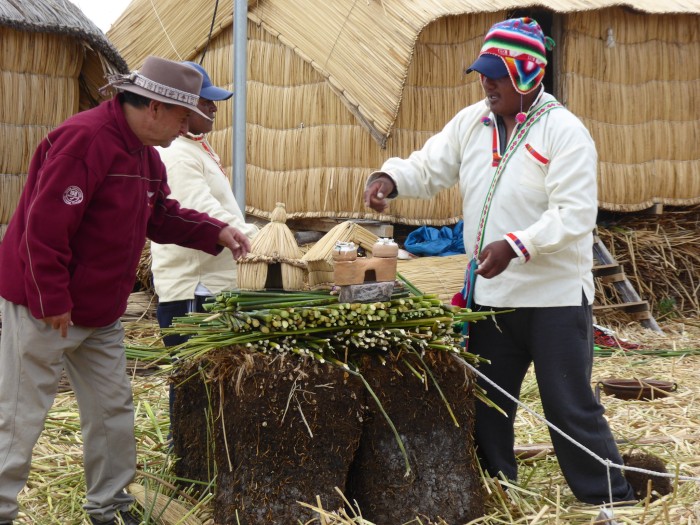Lake Titicaca
28 November 2017

28 November
Well, it was an early start at 7.45, when our guide Abel turned up and walked us down the long boardwalk from the hotel directly to our small cruising boat, waiting by the reed-covered jetty. We climbed aboard and set off, at first through hugh plantations of reeds, then suddenly among some of the ninety floating islands used by the Uros people, who all speak Quechua as well as Spanish. Our boat moored up beside one of them, and we were made welcome by the people. It turned out there were three families on this island. Each family had a house made of reeds, and cooking was done communally on a stove perched on a stone, to avoid setting fire to the reeds. The top man of the island gave us a demonstration in miniature of how an island is built, from scratch. It was amazing. As we sat on the comfortable sausage of reeds in a semicircle listening to the two men, tour boats would go by quite rapidly and the island simply rippled under our feet with the wash passing by. Basically the reed beds nearby in the lake grow in a depth of about 1,5metres of compost or earth into the bottom of the lake. Eventually the very bottom part of their roots rot, and the watchful people can go in and separate sections of the now floating reeds, tow them to a selected spot, add a few more similar sized pieces, lash them all together with rope in stakes on each piece, then put cut reeds in layers, each one at right angles to the last, until you have a floor. Then you can anchor them by weighted ropes to the bottom, and bingo, home sweet home. They build, weave, cook, eat, burn and grow reeds. The island we were on was in 15 metres of water, measured by a plumb line down a hole in the floor.
A bit of a song and dance session followed, then the people all sang one of their traditional songs. We had to reply, so somebody suggested ring a ring a roses, which we all managed, complete with falling down at the end. Much hilarity!
The people make money from tourists by offering craft and knitwear, embroidery and reed carvings for sale, and for giving their visitors a short cruise in their reed boats. Normally they take their goods to a market in Puno entirely operated on the barter principle. We noted that the tourist money had bought them solar panels, so they now have some electricity.
We were encouraged to put on some of their traditional clothes and hats, with hilarious results.
Eventually we disembarked on another island and rejoined our cruiser.
Lake Titicaca is huge, so big you can see a sea horizon in places. It is shared with Bolivia, and it can be seen from certain places in the far distance.
Our next stop was a real island called Taquile, where some 2500 souls live and work. We landed and crawled slowly up a hill to the restaurant, at 4000 metres. Bit short of breath with the effort of walking uphill, but with the help of coca leaves, coca tea and aromatic plants provided by our guide we made it fairly easily.
Lunch was trout caught in the lake. They are not native, but have been introduced from Canada and Argentina, apparently, and do really well. We wondered what the effect on the smaller bonier fish we had seen swimming about in a bowl on the floating island.
After lunch a long amble round the island led us to another jetty where our cruiser awaited. Then a couple of hours in a slight swell and we were back at the hotel. What a day, what an insight into these people's lives, and how welcomed we were by them all. They addressed us through our interpreter as brothers and sisters!
Tomorrow one more archaeological visit then off to the plane to fly back to Lima.



Comments